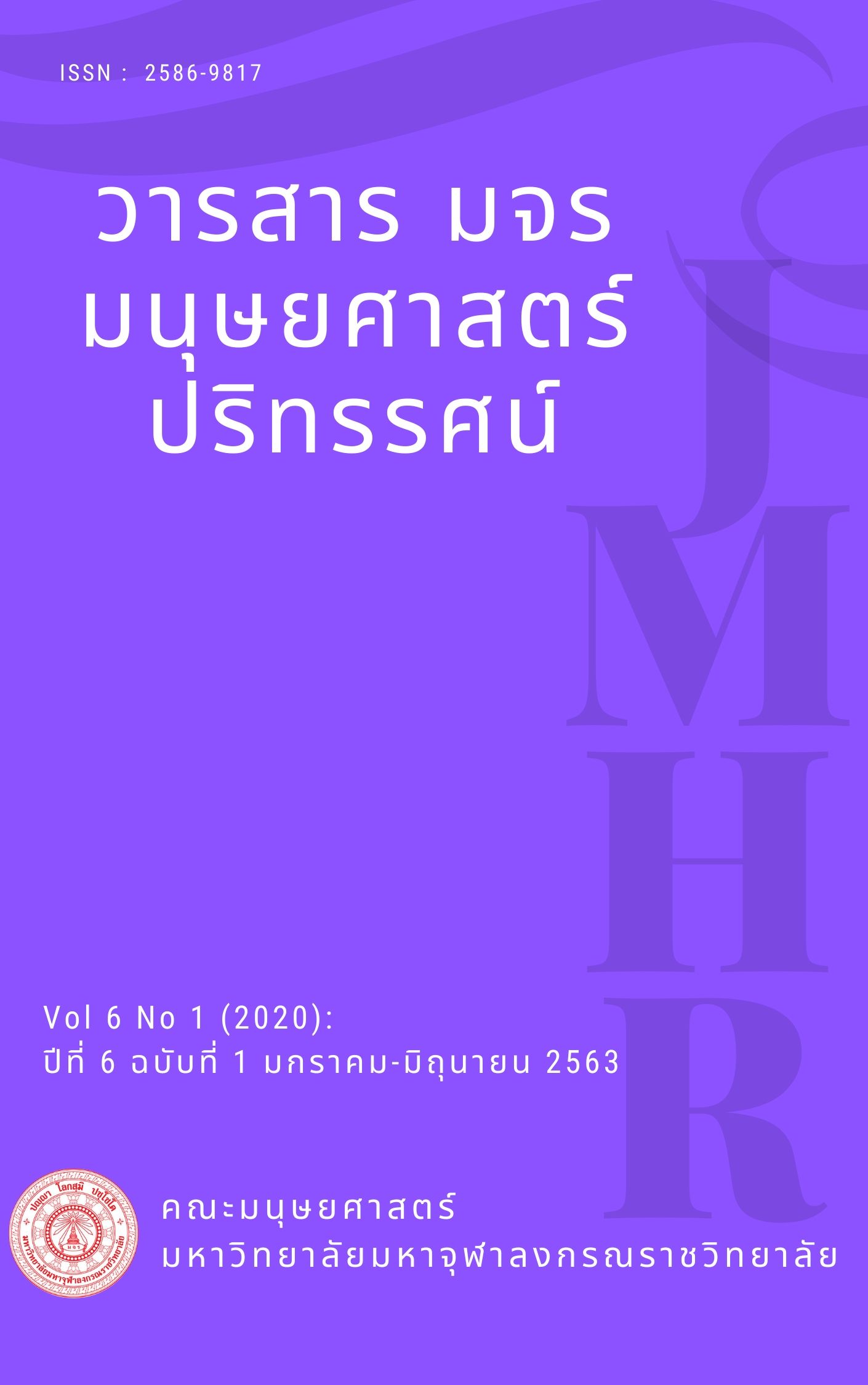การเรียนรู้เพื่อสร้างจิตสำนึกอย่างยั่งยืนต่อสิ่งแวดล้อมตามหลักพุทธวิธี
คำสำคัญ:
การเรียนรู้สู่การเปลี่ยนแปลง, จิตสำนึกสิ่งแวดล้อม, พุทธวิธีการสอนบทคัดย่อ
บทความนี้นำเสนอมุมมองด้านความสัมพันธ์ระหว่างมนุษย์กับสิ่งแวดล้อม รวมไปถึงศึกษาแนวคิดการเรียนรู้สู่การเปลี่ยนแปลงเพื่อสร้างจิตสำนึกที่ดีต่อสิ่งแวดล้อม พร้อมทั้งนำเสนอมุมมองทางพระพุทธศาสนา ที่อธิบายถึงการเรียนรู้ในการสร้างจิตสำนึกต่อสิ่งแวดล้อม ซึ่งมีแนวคิดที่สอดคล้องกันระหว่างแนวคิดการเรียนรู้สู่การเปลี่ยนแปลงและพุทธวิธีการสอนเพื่อสร้างจิตสำนึกต่อสิ่งแวดล้อม ทั้งในมุมมองความสัมพันธ์และพึ่งพิงกันและกันของมนุษย์และสิ่งแวดล้อม การสร้างจิตสำนึกด้วยกระบวนการเรียนรู้สู่การเปลี่ยนแปลง รวมถึง การประยุกต์พุทธวิธีในการเรียนรู้ผ่านกระบวนการเปิดประสบการณ์ของผู้เรียน การสะท้อนเชิงวิพากษ์ และการสนทนา การวิวาทะ โดยใช้เหตุผลต่อมุมมองด้านสิ่งแวดล้อมที่ให้ความสำคัญกับการอยู่กับสิ่งแวดล้อมด้วยความมีเมตตากรุณาต่อทุกสรรพชีวิต
เอกสารอ้างอิง
ประพันธ์ ศุภษร. (2559). พุทธธรรมเพื่อการอนุรักษ์สิ่งแวดล้อม. สืบค้นเมื่อ 24 มกราคม 2563, จาก http://gjn.mcu.ac.th/wp-content/uploads/2015/01/พุทธธรรมเพื่อการอนุรักษ์ สิ่งแวดล้อม.pdf
พระพรหมคุณาภรณ์ (ป.อ. ปยุตฺโต). (2581). เจาะหาความจริงเรื่องศาสนาประจำชาติ. กรุงเทพฯ: มูลนิธิพุทธธรรม.
พระภุชงค์ ปญฺญาวุโฑ. (2562). ศึกษาวิถีจิตในการพิจารณารูปนามในปัจจยปริคคหญาณ (ปริญญาพุทธศาสตรมหาบัณฑิต พธ.ม. สาขาวิชาวิปัสสนาภาวนา). มหาวิทยาลัยมหาจุฬาลงกรณราชวิทยาลัย. พระนครศรีอยุธยา
พระพรหมคุณาภรณ์ (ป.อ. ปยุตฺโต). (2556). พจนานุกรมพุทธศาสตร์ ฉบับประมวลธรรม (พิมพ์ครั้งที่ 21). กรุงเทพมหานคร : บริษัท สหธรรมิก จำกัด.
__________. (2481). หลักกรรมสำหรับคนสมัยใหม่. กรุงเทพฯ: แอคทีฟ พริ้นท์.
__________. (2481). เจาะหาความจริงเรื่องศาสนาประจำชาติ. กรุงเทพฯ: มูลนิธิพุทธธรรม.
มนุษย์ (บุญเชิด หนูอิ่ม. (2015). การเรียนรู้จิตสำนึกด้านสิ่งแวดล้อมตามแนวพุทธปรัชญา. วารสารวิชาการมนุษยศาสตร์และสังคมศาสตร์มหาวิทยาลัยบูรพา, 23(43), 61-83.
สถาบันอาศรมศิลป์. (2561). เรียนรู้คุณค่าแห่งชีวิต. กรุงเทพฯ: บริษัท แปลน ปริ้นติ้ง จำกัด.
อุทัย วรเมธี ศรีสกุล, ชอบดี สวนโคก, อนุสรณ์ นางทะราช, สิทธิพล เวียงคำ, สุภาพ บัวช่วย, และสาคร ศรีระวรรณ. (2018). พุทธวิธีการเรียนการสอน. วารสารบัณฑิตศึกษามหาจุฬาขอนแก่น, 5(1), 71-81.
Belton, T. (2014). Happier People Healthier Planet: How Putting Wellbeing First Would Help Sustain Life on Earth. Silverwood Books, Bristol.
Calvo, M., De Rosa, A. (2017). Design for social sustainability. A reflection on the role of the physical realm in facilitating community Co-design. Des. J. 20 (Suppl. 1), 1705–1724.
Catton Jr, W. R., & Dunlap, R. E. (1980). A new ecological paradigm for post-exuberant sociology. American behavioral scientist, 24(1), 15-47.
Devall, B., Sessions, G., (1985). Deep Ecology: Living as if Nature Mattered. Gibbs Smith Publisher, Layton, Utah.
Jones, P., Evans, J., (2012). Rescue geography: place making, affect and regeneration. Urban Stud. 49 (11), 2315–2330.
O’Brien, K. (2013). Global environmental change III: Closing the gap between knowledge and action. Progress in Human Geography, 37(4), 587-596.






